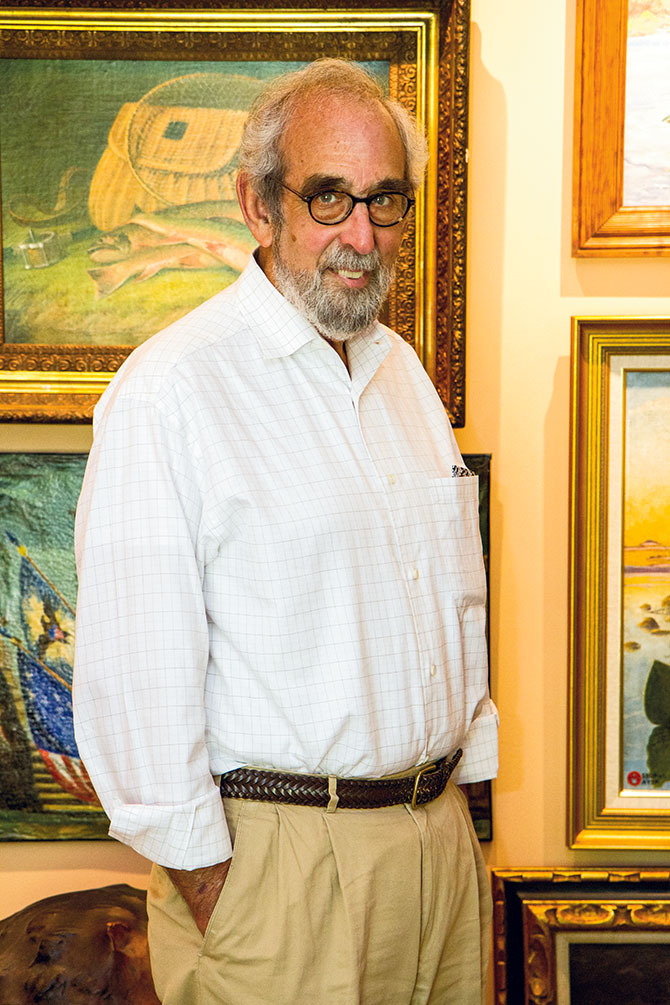 |
| Allan Weiss discovered a part of Kentucky’s history that is on display at the Frazier History Museum. Photos by Patti Hartog |
Allan Weiss journeyed through American history to inspire the Frazier History Museum’s upcoming exhibit
By Lucy M. Pritchett
Just ask Allan Weiss. His interest in walking sticks, duck decoys, and fishing lures led to his discovery of the Federal Art Project’s Index of American Design. The Index then fueled this history mystery detective’s investigation that inspired the Kentucky by Design exhibit at the Frazier History Museum.
“My interest in all this started in the mid-1970s when I developed a fascination with Kentucky folk art,” says Allan, a Louisville native and retired attorney. “As I was doing research and educating myself on the items I was collecting, I came across the Index of American Design. This was a Depression-era project by the Works Project Administration (WPA) and was a subset of the Federal Art Project.”
During the Depression, the FAP hired hundreds of unemployed artists from all over the United States to identify and record items of historical significance produced or made in America before 1900. Artists in 36 states painted 18,000 watercolors of everyday objects representing an authentic American style: pottery, quilts, textiles, furniture, tools, wrought iron, and musical instruments.
This audacious project began at the end of 1935 and ran for just over six years.
Then, America’s involvement in World War II put an end to it. Since 1943, the individual watercolors of the objects have been stored in the Smithsonian Institution’s National Gallery of Art in Washington, D.C.
“I became interested in finding out about the objects from Kentucky that were included in the Index,” Allan says. “I went to the National Gallery and discovered that there were data sheets for each object. My first trip was in 1990 or ’91. At that time I found four or five folders that contained the data sheets. Only about half of the data sheets were filled out completely with a description of the object, who owned it — institution or individual — and the artist who had painted the watercolor. My mission became to discover where those objects were now.”
 |
| This photo, John Jacob Niles Outdoors with a Dulcimer, was taken by George Kossuth in 1942. Niles was a Kentucky native and a singer, composer, and luthier. |
 |
| The Niles “B” dulcimer is from his collection. Both the photo and the dulcimer are part of the Kentucky by Design exhibit. |
This meant hours spent in dusty record rooms of Kentucky courthouses looking through wills and estate documents. Sometimes it meant knocking on the doors of strangers to determine where the original owner was now or what relative might have inherited a certain item.
About 90 percent of the objects were in institutions such as the Speed Museum, the Filson Club, Liberty Hall in Frankfort, or Shaker Village of Pleasant Hill, Allan says. Some of the curators weren’t even aware that they had objects that were listed in the national Index.
“One of my best finds was an iron trivet,” Allan says. “I had seen it in the Index, and it fascinated me. It was blacksmith-made. It swiveled, and you would put an iron pot on it and set it on the hearth. Then by turning the pot, the stew or the soup would cook. I thought that was spectacular. The data sheet showed that it was at Fort Harrod. I visited the fort and found it on display in one of the cabins. The park manager didn’t know that it was part of the Index. Items like this take on a special meaning — someone thought it was important enough to document this trivet.”
Eventually Allan had gone as far as he could go with his investigations. Until now, no one had researched the collection of the national Index items in a single state. “I thought it would be wonderful to have some kind of an exhibit where the object and its watercolor rendering would be on display together,” Allan says.
Hence the Kentucky by Design exhibit at the Frazier History Museum, which runs through February 12, 2017. Of the 218 Kentucky artifacts documented for the Index of American Design, the exhibit includes 20 matched with their original watercolors from the National Gallery of Art along with another 67 objects paired with prints of their watercolors.
Allan contributed the foreword to the book Kentucky by Design: The Decorative Arts and American Culture that has been published to accompany the exhibit with photographs and essays concerning the project. Included are oral history interviews with Adele Brandeis, who supervised the Index of American Design in Kentucky, and Holger Cahill, the national director of the Federal Art Project.
Leave a Reply